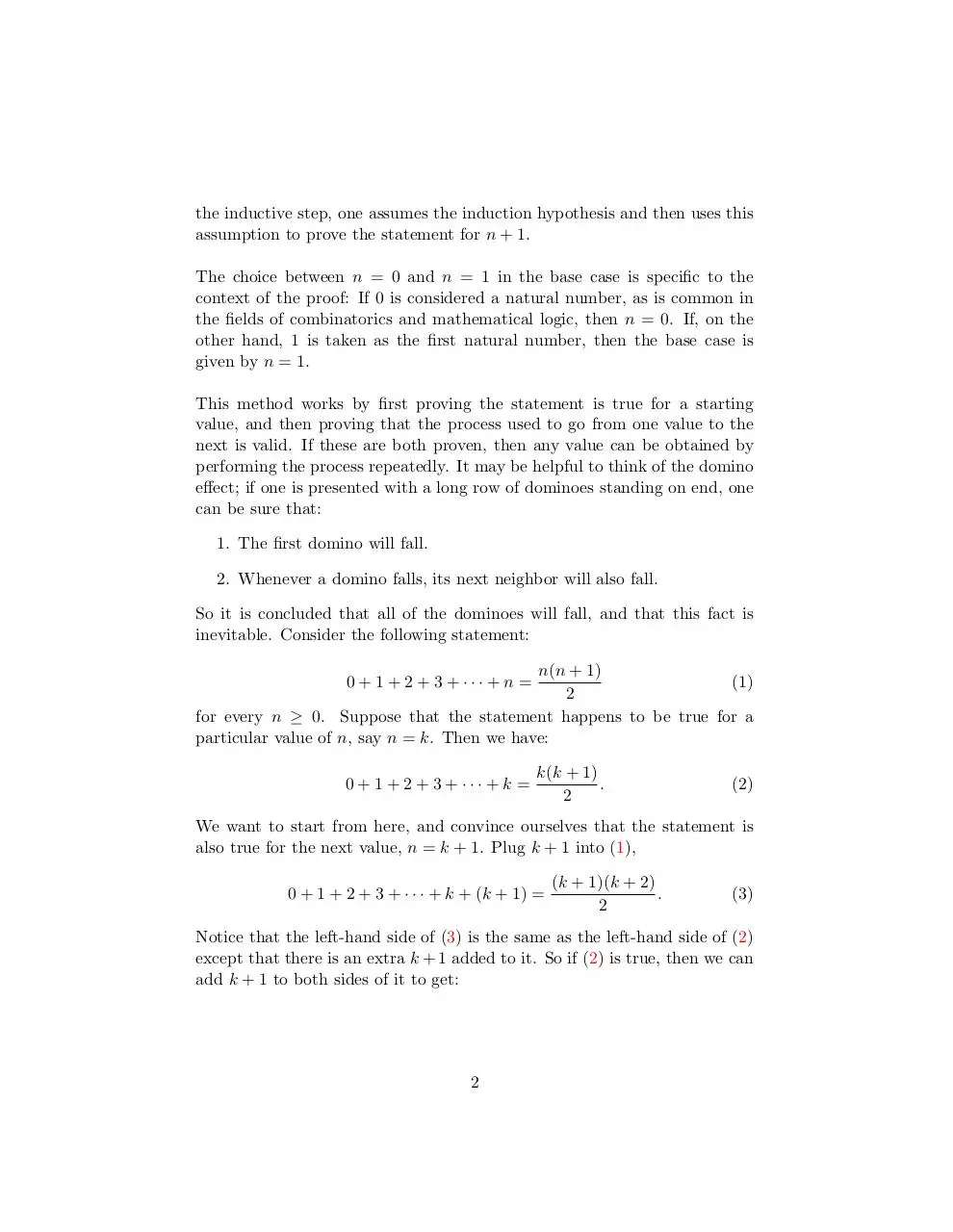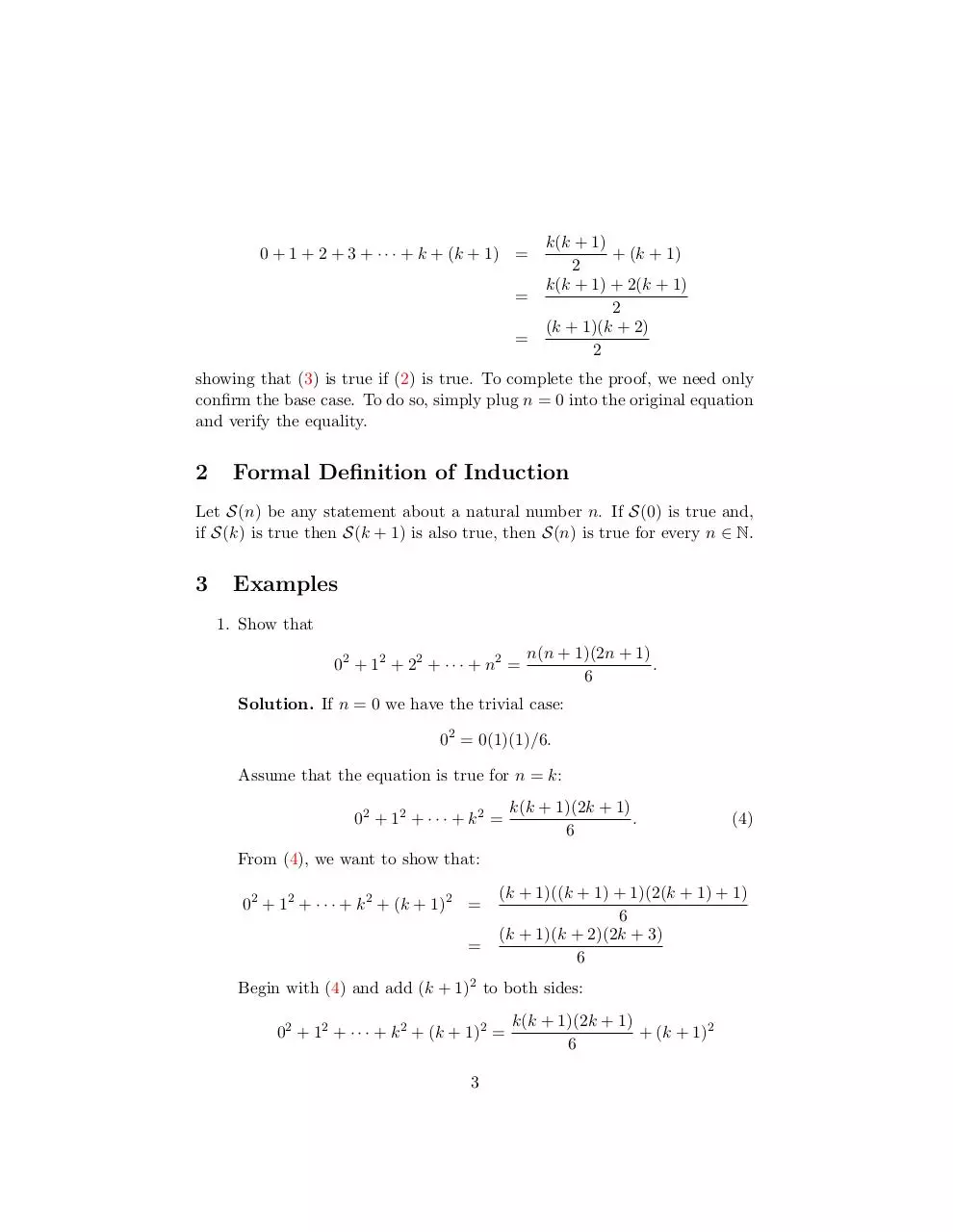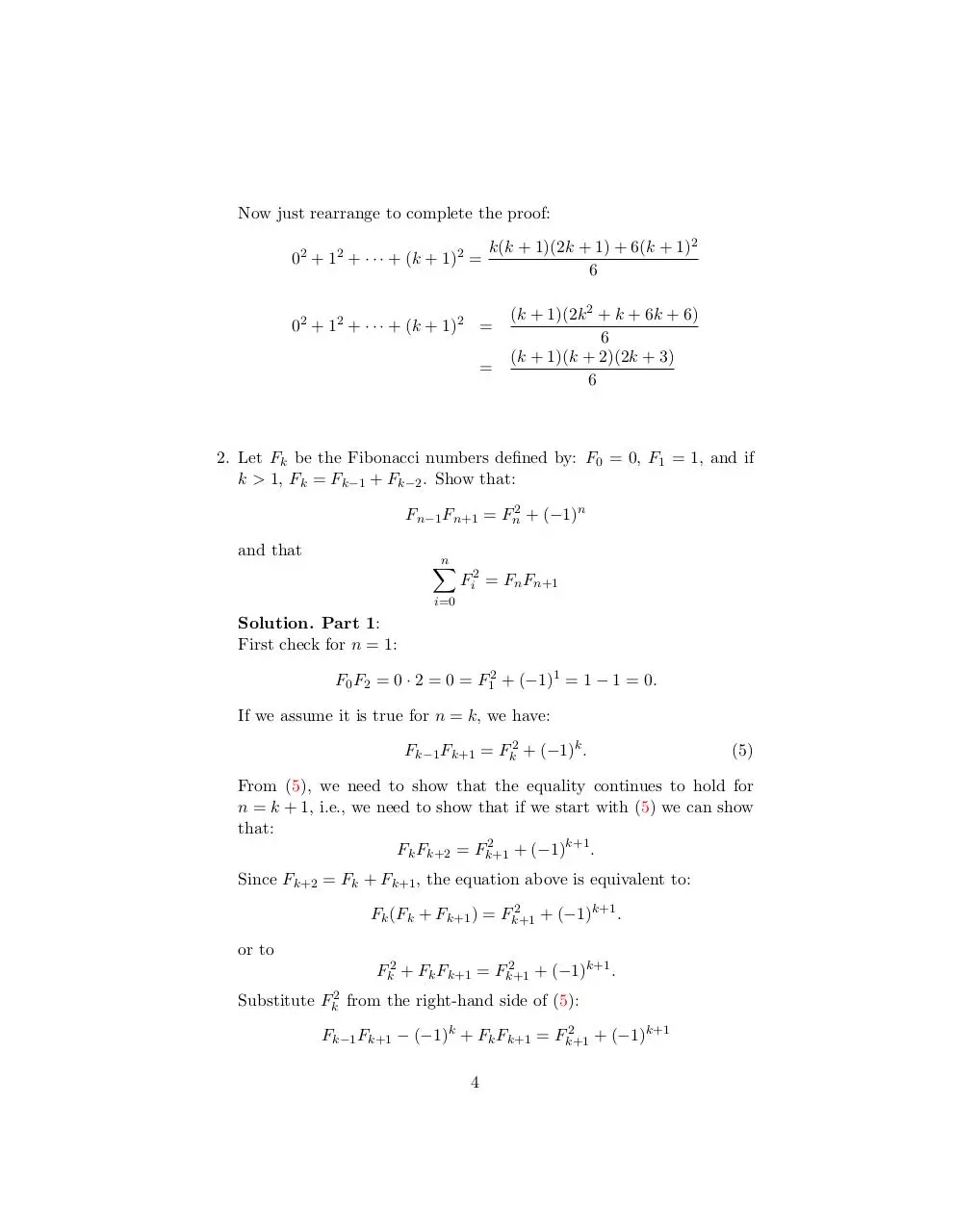induction (PDF)
File information
Title: 000.3 - Mathematical Induction
Author: James Bonnar
This PDF 1.4 document has been generated by LaTeX with hyperref package / pdfTeX-1.40.3, and has been sent on pdf-archive.com on 28/07/2011 at 13:34, from IP address 98.144.x.x.
The current document download page has been viewed 1601 times.
File size: 114.89 KB (8 pages).
Privacy: public file





File preview
000.3 - Mathematical Induction
c
2010
Treasure Trove of Mathematics
Mathematical induction is a method of mathematical proof typically used to
establish that a given statement is true of all natural numbers (non-negative
integers).1 It is done by proving that the first statement in the infinite sequence of statements is true, and then proving that if any one statement in
the infinite sequence of statements is true, then so is the next one.
Mathematical induction should not be misconstrued as a form of inductive
reasoning, which is considered non-rigorous in mathematics. In fact, mathematical induction is a form of rigorous deductive reasoning.
1
Introduction
The natural numbers, N, is the set of all non-negative integers:
N = {0, 1, 2, 3, . . .}.
Very often we want to prove some mathematical statement involving every
member of N. The simplest and most common form of mathematical induction proves that a statement involving a natural number n holds for all
values of n. The proof consists of two steps:
1. The basis (base case): showing that the statement holds when n is
equal to the lowest value that n is given in the question. Usually,
n = 0 or n = 1.
2. The inductive step: showing that if the statement holds for some n,
then the statement also holds when n + 1 is substituted for n.
The assumption in the inductive step that the statement holds for some
n is called the induction hypothesis (or inductive hypothesis). To perform
1
This document may be freely distributed, but not altered.
1
the inductive step, one assumes the induction hypothesis and then uses this
assumption to prove the statement for n + 1.
The choice between n = 0 and n = 1 in the base case is specific to the
context of the proof: If 0 is considered a natural number, as is common in
the fields of combinatorics and mathematical logic, then n = 0. If, on the
other hand, 1 is taken as the first natural number, then the base case is
given by n = 1.
This method works by first proving the statement is true for a starting
value, and then proving that the process used to go from one value to the
next is valid. If these are both proven, then any value can be obtained by
performing the process repeatedly. It may be helpful to think of the domino
effect; if one is presented with a long row of dominoes standing on end, one
can be sure that:
1. The first domino will fall.
2. Whenever a domino falls, its next neighbor will also fall.
So it is concluded that all of the dominoes will fall, and that this fact is
inevitable. Consider the following statement:
n(n + 1)
(1)
2
for every n ≥ 0. Suppose that the statement happens to be true for a
particular value of n, say n = k. Then we have:
0 + 1 + 2 + 3 + ··· + n =
0 + 1 + 2 + 3 + ··· + k =
k(k + 1)
.
2
(2)
We want to start from here, and convince ourselves that the statement is
also true for the next value, n = k + 1. Plug k + 1 into (1),
0 + 1 + 2 + 3 + · · · + k + (k + 1) =
(k + 1)(k + 2)
.
2
(3)
Notice that the left-hand side of (3) is the same as the left-hand side of (2)
except that there is an extra k + 1 added to it. So if (2) is true, then we can
add k + 1 to both sides of it to get:
2
0 + 1 + 2 + 3 + · · · + k + (k + 1) =
=
=
k(k + 1)
+ (k + 1)
2
k(k + 1) + 2(k + 1)
2
(k + 1)(k + 2)
2
showing that (3) is true if (2) is true. To complete the proof, we need only
confirm the base case. To do so, simply plug n = 0 into the original equation
and verify the equality.
2
Formal Definition of Induction
Let S(n) be any statement about a natural number n. If S(0) is true and,
if S(k) is true then S(k + 1) is also true, then S(n) is true for every n ∈ N.
3
Examples
1. Show that
02 + 1 2 + 2 2 + · · · + n2 =
n(n + 1)(2n + 1)
.
6
Solution. If n = 0 we have the trivial case:
02 = 0(1)(1)/6.
Assume that the equation is true for n = k:
02 + 12 + · · · + k 2 =
k(k + 1)(2k + 1)
.
6
(4)
From (4), we want to show that:
02 + 12 + · · · + k 2 + (k + 1)2 =
=
(k + 1)((k + 1) + 1)(2(k + 1) + 1)
6
(k + 1)(k + 2)(2k + 3)
6
Begin with (4) and add (k + 1)2 to both sides:
02 + 12 + · · · + k 2 + (k + 1)2 =
3
k(k + 1)(2k + 1)
+ (k + 1)2
6
Now just rearrange to complete the proof:
02 + 12 + · · · + (k + 1)2 =
k(k + 1)(2k + 1) + 6(k + 1)2
6
02 + 12 + · · · + (k + 1)2 =
=
(k + 1)(2k 2 + k + 6k + 6)
6
(k + 1)(k + 2)(2k + 3)
6
2. Let Fk be the Fibonacci numbers defined by: F0 = 0, F1 = 1, and if
k > 1, Fk = Fk−1 + Fk−2 . Show that:
Fn−1 Fn+1 = Fn2 + (−1)n
and that
n
X
Fi2 = Fn Fn+1
i=0
Solution. Part 1:
First check for n = 1:
F0 F2 = 0 · 2 = 0 = F12 + (−1)1 = 1 − 1 = 0.
If we assume it is true for n = k, we have:
Fk−1 Fk+1 = Fk2 + (−1)k .
(5)
From (5), we need to show that the equality continues to hold for
n = k + 1, i.e., we need to show that if we start with (5) we can show
that:
2
Fk Fk+2 = Fk+1
+ (−1)k+1 .
Since Fk+2 = Fk + Fk+1 , the equation above is equivalent to:
2
Fk (Fk + Fk+1 ) = Fk+1
+ (−1)k+1 .
or to
2
Fk2 + Fk Fk+1 = Fk+1
+ (−1)k+1 .
Substitute Fk2 from the right-hand side of (5):
2
Fk−1 Fk+1 − (−1)k + Fk Fk+1 = Fk+1
+ (−1)k+1
4
or
2
2
Fk+1 (Fk−1 + Fk ) = Fk+1
+ (−1)k+1 + (−1)k = Fk+1
or
2
2
Fk+1
= Fk+1
Part 2:
For n = 0:
0
X
Fi2 = F02 = 0 = F0 F1 = 0 · 1 = 0
i=0
If it is true for n = k:
k
X
Fi2 = Fk Fk+1
i=0
2
then we can Fk+1
to both sides of (6) to get:
k+1
X
2
= Fk+1 (Fk + Fk+1 ) = Fk+1 Fk+2
Fi2 = Fk Fk+1 + Fk+1
i=0
3. Show that:
√
1
1
1
1 + √ + √ + · · · + √ ≤ 2 n.
n
2
3
Solution. For the n = 1 case we have
√
1 ≤ 2 1 = 2.
Assume the equation is true for n = k:
√
1
1
1
1 + √ + √ + · · · + √ ≤ 2 k.
2
3
k
√
To show it is also true for n = k + 1, add 1/ k + 1 to both sides:
√
1
1
1
1
1 + √ + ··· + √ + √
≤2 k+ √
.
k+1
k+1
2
k
Thus if we can show that
√
√
1
2 k+ √
≤2 k+1
k+1
5
(6)
√
then the proof is complete. Multiply both sides by k + 1 and then
square both sides to obtain:
p
4k(k + 1) + 4 k(k + 1) + 1 ≤ 4(k 2 + 2k + 1).
p
4 k(k + 1) ≤ 4k + 3
Squaring again:
16k 2 + 16k ≤ 16k 2 + 24k + 9
which is always true.
4. Show that:
2! · 4! · 6! · · · (2n)! ≥ ((n + 1)!)n .
Solution. First show it is true for n = 1:
2! = 2 ≥ (2!)1 = 2.
Next assume it is true for n = k:
2! · 4! · 6! · · · (2k)! ≥ ((k + 1)!)k .
(7)
If we multiply both sides of (7) by (2(k + 1))!, we get:
2! · 4! · · · (2k)! · (2k + 2)! ≥ ((k + 1)!)k · (2k + 2)!.
If it can be shown that the right-hand side of the equation above is
larger than ((k + 2)!)k+1 , the proof is complete. The term (2k + 2)! on
the right-hand side can be written:
(2k + 2)! = (2k + 2)(2k + 1)(2k) · · · (k + 3)(k + 2)!
This consists of k terms, all greater than k + 2, multiplied by (k + 2)!,
so
((k + 1)!)k (2k + 2)! > ((k + 1)!)k (k + 2)k (k + 2)!
= ((k + 2)!)k (k + 2)! = ((k + 2)!)k+1
6
5. Show that:
s
2+
r
q
√
π
2 + 2 + · · · + 2 = 2 cos n+1
2
where there are n 2s in the expression on the left.
Solution. For n = 1 case we have:
√
√
√
π
2 = 2 cos 2 = 2 cos π/4 = 2 2/2 = 2.
2
Now assume it is true for k nested square roots:
s
r
q
√
π
2 + 2 + 2 + · · · + 2 = 2 cos k+1 .
2
Add 2 to both sides and take the square root, so the LHS will have
k + 1 nested square roots, and the right hand side will be:
r
π
2 + 2 cos k+1 .
(8)
2
All we need to show is that the value above is equal to
2 cos
π
2k+2
.
We know that for any angle θ we have:
r
1 + cos 2θ
cos θ =
.
2
(9)
(10)
Substitute π/2k+2 for θ in 10 and the equality of 8 and 9 becomes
immediately obvious.
4
References
1. H. Amann, J. Esher, Analysis 1, Birkhauser Basel; 1st edition, 2010.
2. H. Amann, J. Esher, Analysis 2, Birkhauser Basel; 1st edition, 2008.
3. H. Amann, J. Esher, Analysis 3, Birkhauser Basel; 1st edition, 2009.
4. S. Lay, Analysis: With an Introduction to Proof, Prentice Hall; 4th
edition, 2004.
7
5. S. Hedman, A First course in Logic: An Introduction to Model Theory, Proof Theory, Computability, and Complexity, Oxford University
Press; 2004.
6. R. Larson, B. Edwards, Calculus, Brooks Cole; 9th edition, 2009.
7. R. Larson, R. Hostetler, B. Edwards, Calculus (With Analytic Geometry), Brooks Cole; 8th edition, 2005.
8. M. Lial, J. Hornsby, D. Schneider, College Algebra, Addison Wesley;
10th edition, 2008.
9. C. Mckeague, M. Turner, Trigonometry, Brooks Cole; 6th edition,
2007.
10. M. Lial, J. Hornsby, D. Schneider, Trigonometry, Addison Wesley; 9th
edition, 2008.
11. R. Larson, Trigonometry, Brooks Cole; 8th edition, 2010.
12. R. Moyer, F. Ayres, Schaum’s Outline of Trigonometry, McGraw-Hill;
4th edition, 2008.
13. G.F. Simmons, Precalculus Mathematics in a Nutshell, Wipf & Stock
Publishers; 2003.
14. M. Sullivan, Trigonometry: A Unit Circle Approach, Prentice Hall;
8th edition, 2007.
15. R. Larson, Algebra and Trigonometry, Brooks Cole; 5th edition, 2000.
8
Download induction
induction.pdf (PDF, 114.89 KB)
Download PDF
Share this file on social networks
Link to this page
Permanent link
Use the permanent link to the download page to share your document on Facebook, Twitter, LinkedIn, or directly with a contact by e-Mail, Messenger, Whatsapp, Line..
Short link
Use the short link to share your document on Twitter or by text message (SMS)
HTML Code
Copy the following HTML code to share your document on a Website or Blog
QR Code to this page

This file has been shared publicly by a user of PDF Archive.
Document ID: 0000032433.